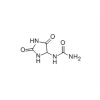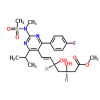|
公司基本資料信息
|
|||||||||||||||||||||||||||||
Synonym: (alphaS,4R)-alpha-Ethyl-2-oxo-4-propyl-1-pyrrolidineacetamide;UCB-34714;1-PyrrolidineacetaMide, α-ethyl-2-oxo-4-propyl-, (αS,4R)-;(S)-2-((R)-2-oxo-4-propylpyrrolidin-1-yl)butanaMide;2(S)-[2-Oxo-4(R)-propylpyrrolidin-1-yl]butyramide;(2S)-2-[(4R)-2-oxo-4-propylpyrrolidin-1-yl]butanamide;API-Anti Epilepsy;brivaracetam
MF: C11H20N2O2
MW: 212.29
Product Category: API;APIs;Brain health drug;Nootropic
Melting Point: 76.38°
Alpha: D25 -60.57° (c = 1 in methanol)
Boiling Point: 409.3±28.0 °C(Predicted)
Density: 1.062
pKa: 15.74±0.50(Predicted)
Description: Brivaracetam, a chemical analog of Levetiracetam, is a racetam derivative with anticonvulsant effect. It is used for the treatment of partial-onset seizures with or without secondary generalisation, in combination with other antiepileptic drugs. The exact mechanism of brivaracetam's anti-epileptogenic activity is unknown. What is known is thatbrivaracetam binds SV2A with high affinity. SV2A is known to play a role in epileptogenesis through modulation of synaptic GABA release. It is thought that brivaracetam exerts its anti-epileptogenic effects through its binding to SV2A. Brivaracetam can also inhibit Na+ channels which may also contribute to its anti-epileptogenic action.
Overview and History: Brivaracetam is an orally bioavailable levetiracetam derivative, with anticonvulsant activity. It can be used in the treatment of partial-onset seizures. Brivaracetam binds SV2A with 20 times higher affinity than levetiracetam. It is available under the brand name Briviact made by UCB. It was approved by the federal drug administration of USA[FDA] on Feb 19th 2016.
Application: Brivaracetam is indicated for the treatment of partial-onset seizures in patients 4 years of age and older. It provides a new monotherapy treatment option for epilepsy patients 16 years of age and older who suffering partial-onset[focal] seizures, which can be initiated at a therapeutic dose at day one.
Mode of Action: The accurate mode of action of brivaracetam remains unclear. It is known that Brivaracetam can strongly bind to SV2A, which is known to play a role in epileptogenesis through modulation of synaptic GABA release. It is thought that brivaracetam exerts its anti-epileptogenic effects through its binding to SV2A. It may access the luminal side of recycling synaptic vesicles during vesicular endocytosis, which may reduce excitatory neurotransmitter release and enhance synaptic depression during trains of high-frequency activity, such as is believed to occur during epileptic activity. Brivaracetam is also known to inhibit Na+ channels which may also contribute to its anti-epileptogenic action.
Adverse Reactions: The most frequently reported adverse reactions associated with brivaracetam treatment are somnolence and dizziness (both somnolence and fatigue are reported with a higher incidence with increasing dose). Preliminary metaanalytic data comparing the incidence of behavioural problems in brivaracetam and levetiracetam trials (used as adjunctive therapy in adults with uncontrolled partial- onset epilepsy) showed that the incidence of non- psychotic behavioural treatment emergent adverse effects was considerably lower with brivaracetam treatment (6.8%) compared with levetiracetam (10.9%), wheras the incidences in placebo arms were similar (4.2 and 4.8%, respectively). The placebo- adjusted incidence rates were 2.6% for brivaracetam and 6.8% for levetiracetam, resulting in a brivaracetam/levetiracetam Odds Ratio of 0.68. Brivaracetam has a low interaction potential, although it is not recommended for use with concomitant levetiracetam.
Dose Titration: Brivaracetam is known under the proprietary name of Briviact® (UCB Pharma, Slough) in the UK and USA. Brivaracetam is available in different pharmaceutical forms (10-25-50-75-100 mg film- coated tablets and 10 mg/ mL oral solution). Brivaracetam is initially prescribed at the dose of 50–100 mg daily, divided into two doses. based on individual patient response and tolerability, the dose may be adjusted within the dose range of 50– 200 mg daily. Brivaracetam is recommended as an adjunctive AED treatment for partial- onset seizures with or without secondary generalization. Brivaracetam exhibits greater antiepileptic properties than levetiracetam in animal models, but with a somewhat smaller (although still high) therapeutic range. Moreover, brivaracetam requires no up- titration to reach therapeutic doses and there is no recommendation for specific monitoring. Exposure to brivaracetam is increased in patients with chronic liver disease. A starting dose of 50 mg daily should be considered and a maximum daily dose of 150 mg administered, divided into two doses, is recommended for all stages of hepatic impairment. If patients missed one dose or more, it is recommended that they take a single dose as soon as they remember and take the following dose at the usual morning or evening time, in order to avoid the brivaracetam plasma concentration falling below the efficacy level and prevent breakthrough seizures from occurring. If brivaracetam has to be discontinued, it is recommended to withdraw it gradually by 50 mg daily on a weekly basis. After 1 week of treatment at 50 mg daily, a final week of treatment at the dose of 20 mg daily is recommended.
Description: Brivaracetam, a novel oral antiepileptic drug with a high affinity for synaptic vesicle protein 2A (SV2A), was approved in Europe and the US as an adjunctive therapy for the treatment of partial onset seizures with or without secondary generalization in patients aged 16 or older.42 Brivaracetam is very closely related to levetiracetam, an antiepileptic treatment whose immediate release formulation has been available in the United States as a generic drug since 2008, but whose extended release formulation is under patent protection until 2028. The two drugs, which were both developed by UCB Pharma, are structurally similar with brivaracetam having an n-propyl group at the C-4 position of the pyrrolidinone ring and levetiracetam having a hydrogen at this same position. A systematic investigation of the various substitutions of levetiracetam resulted in the identification of more potent and selective SV2A ligands and ultimately culminated in the discovery of brivaracetam, which has greater affinity for SV2A, improved selectivity, more rapid brain penetration, and faster onset of action against seizures than levetiracetam.
Uses: reatment ofTreatment of epilepsy, neuropathic pain and essential tremor.





 通過(guò)認(rèn)證
通過(guò)認(rèn)證 








